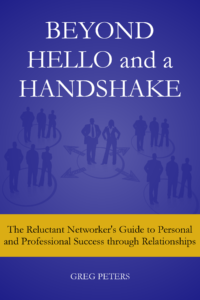 Welcome to another in the series of sneak peaks of early draft material from my upcoming book, Beyond Hello and a Handshake. Don’t tell anyone you are getting early access. It will just make them jealous.
Welcome to another in the series of sneak peaks of early draft material from my upcoming book, Beyond Hello and a Handshake. Don’t tell anyone you are getting early access. It will just make them jealous.
———————————-
“Choose to focus your time, energy and conversation around people who inspire you, support you and help you to grow you into your happiest, strongest, wisest self.”
~ Karen Salmansohn
You’ve made it to your one-to-one. You are prepared. You are a little early. You’ve found a good seat and you’ve gotten your beverage of choice or had a chance to look over the menu, depending on whether you are meeting for lunch, breakfast, coffee, or whatever. Your networking companion has just walked through the door and now it’s time to get connecting!
So, what should you do and when during the actual get-together? Let’s break it down. Please note, these times assume a sixty minute one-to-one. Make adjustments if you go shorter or longer.
- As soon as they walk in. Greet them. I shouldn’t have to say this, but let’s just make sure we are crystal clear: When your partner shows up, you stand to welcome them and offer a firm and friendly handshake. Standing when the other person arrives shows respect. It’s not a male/female thing. It’s a human thing.
Be aware: Some people are natural huggers. Unless you know the other person well enough to know they will have no problem reciprocating a hug, stick with a handshake. If they move to give you a hug, feel free to respond in kind. As a six-foot-two guy, I realize that I might seem slightly imposing to others so I am hyper-sensitive to this. I don’t want the person I am meeting to feel threatened. It’s not a good way to start a long-term, professional relationship. - As soon as they sit down. Put the phone away. There is almost no reason you should have your phone visible at the table. It sends the signal to the other person that you could at any moment decide that an incoming call is more important than they are. Not cool. If you do have some incipient emergency (your spouse is pregnant and could go into labor at any time) let the other person know the situation.
Also, if you decide to set a silent alarm so you know when the end of the coffee is supposed to be, let them know. I do this because I know as a speaker and a networker, I can get caught up in the conversation and keep my partner long after they should have returned to their daily routine. - The next fifteen minutes. Between greetings and getting beverages, you are already likely five minutes into your hourlong one-to-one. Spend the remainder of the first twenty minutes catching up. Remember, this is a connection between two people — a relationship. You should spend part of your time together just sharing what’s been happening in your lives. This isn’t merely small talk. Use a tool like INFER to direct the conversation to try to discover ways to help them. Pull out your notebook and ask them if it’s OK to jot down a few notes.
- From twenty to forty minutes. Focus more directly on how you can help. Ask them that question specifically. They may not know exactly or they may be too general (“Send some work my way”). This would be a good time to work with them on coming up with a more specific request. If they are looking for more business, ask them questions to find out specifically what they want. If after drilling down a little you discover that you can’t really help them, the next thing to do is ask who would normally give them such a referral. Once again, you may have to drill down to get the specifics, but look for a way to connect them with such a stepping stone.
- From forty to fifty-five minutes. If they don’t specifically ask how they can help you, you may have to broach the subject yourself (“Kyle, I was wondering if you’d be willing to help me out with something”). Remember that you have picked out a request that you think they are going to be able and willing to help.
- The next couple minutes. Rehash what you have promised to do for each other. Be sure you have recorded it in your notes.
- The final minutes. Establish when a good next contact would be. “I’d love to stay in touch. How about I drop you an email early next month? I want to hear what’s been going on with your new initiative.” Of course, if you’ve promised to do something for them in the meantime, you’ll be in touch sooner.
- The end. Handshakes (or hugs, if appropriate). Thank them for their time and share a little small talk as you head for the door.
You now have a rough road map of how to carry on a one-to-one get-together. You may want to adjust as needed. Use this as a guideline. Remember, unlike a conversation at a networking event, where you should let them do most of the talking, in this case there should be an almost equal contribution from both of you.
Never let a one-to-one be just a pleasant hour or more of chatting. You are both there for a purpose — to find ways to be of service to each other and to get help in return. Follow a process with that as its purpose and you will walk out at the end with more than just the memory of a firm handshake.

